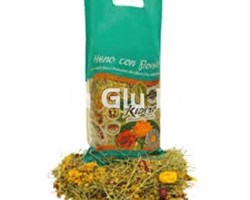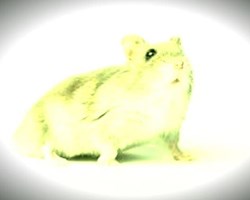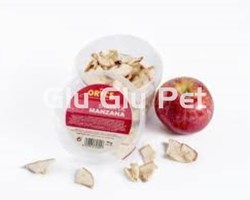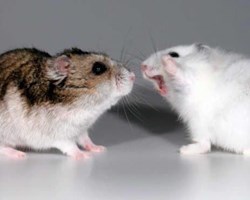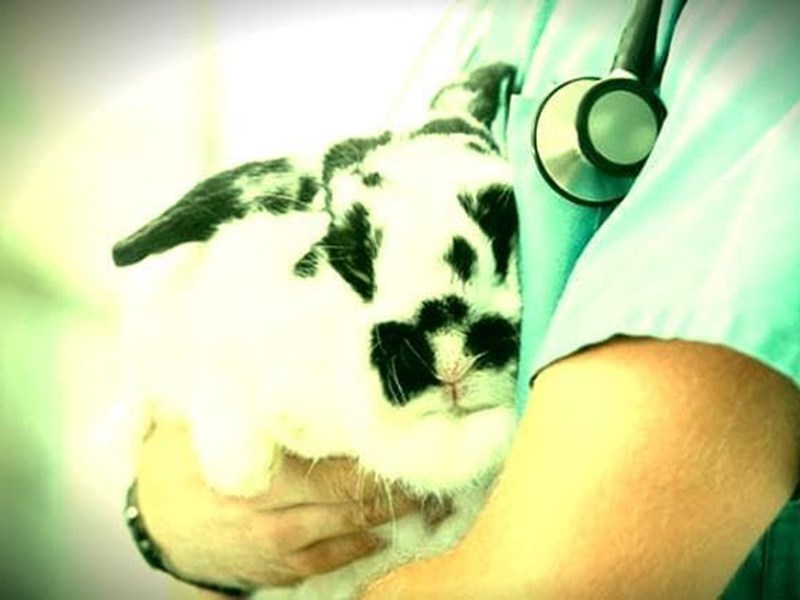
DOMESTIC RABBITS:
Domestic rabbits are becoming more and more popular as animals to have at home with us, but to take really good care of them, we must know aspects of their health, which can be very delicate.
There are various diseases that rabbits can have, some very common in field rabbits and, on the contrary, others much more common in home rabbits.
If you see any warning signs in your rabbit's health, don't hesitate to go to the vet immediately for evaluation.
The most common diseases in rabbits are those related to the digestive system, which occur from the mouth to the end of the intestines.
Digestive problems in rabbits can occur because we offer them an inadequate diet (nutritional problems) or, due to aspects that have nothing to do with what they eat, but with their environment, the state of health of different organs of the animal or other aspects.

THE MOST COMMON DISEASES ARE:
- Gut hypomotility.
- Excessive growth of the teeth.
- Diarrhea.
- Apart from these health problems, there are others related to different aspects of your health that we will also cover later.
INTESTINAL HYPOMOTILITY IN RABBITS, A DEADLY DISEASE:
Although it is one of the most common diseases in rabbits and it is one of the most serious, it is not well known among people who have one of these animals at home, especially if it is the first time.
Intestinal or digestive hypomotility is a problem in which the normal movement of the intestines (peristalsis) stops happening, the intestines stop moving, there are no longer muscle contractions that move the food and facilitate its digestion and absorption of nutrients.
This can happen, mainly, for two reasons or causes:
- 6 hours without eating: rabbits are always eating, as they cannot go for many hours without eating. Specifically, around 6 hours without eating they begin to suffer from reduced movement in the intestines, until they stop completely, and this produces a series of secondary problems that can lead the rabbit to die in a short time.
- A lot of sugar and little fiber: when rabbits have an inadequate diet for them, such as, for example, excess carbohydrates or sugars and little fiber (precisely, rabbits need plenty of fiber and just the right sugars), the intestines begin to fail and hypomotility occurs.
For this reason, it is very important to offer a diet that is adequate to the needs of the rabbit, reducing treats as much as possible, and allowing it to always have food within its reach and not spend several hours without eating.
If we detect that the rabbit does not move and we know that one of the two factors indicated above has occurred, it is likely that it is beginning to suffer from this problem and we must take it to the veterinary emergency room.
There they must give him a shock treatment with strong fluid therapy, among other care, to prevent his death.
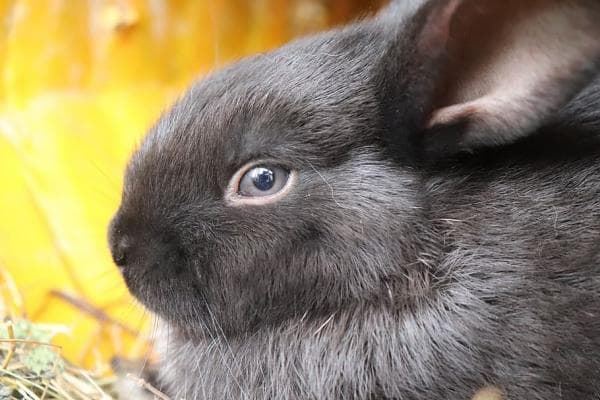
EXCESSIVE GROWTH OF RABBITS TEETH:
These small mammals are rodents, which are always biting or gnawing on food or objects in order to wear down their teeth.
This is because they need to have strong teeth that allow them to thoroughly chew the hard fibers of the large number of vegetables they must eat every day.
Thus, their teeth are strong and grow throughout their lives to ensure good teeth and that, in the event of serious wear on them, this does not pose a problem, because if they were fixed and durable teeth like ours they could lose their functionality with ease.
Rabbits' teeth grow very fast, about 1 mm a week, and when they are not worn down they suffer from serious problems, which is common in domestic rabbits and rare in free range rabbits.
They can suffer from what is known as dental overgrowth or excessive growth of the teeth, which causes a dental malocclusion, shifting the jaws, preventing the animal from eating normally (they can even stop eating completely) since they become wounds on the chin or gums.
It is common that if the owner of the rabbit does not realize this, an infection appears in the wound, further worsening the health of the animal.
Finally, if left untreated the rabbit can die of starvation or infection.

HOW TO AVOID THE EXCESSIVE GROWTH OF THE RABBIT'S TEETH:
It really is a very easy problem to avoid, offering adequate food to the rabbit so that it can eat well and wear down its teeth correctly (hay and other vegetables are essential, such as green leaves of carrots, cabbage, etc., avoiding giving too many tubers, soft roots, seeds, treats or feed; of which small amounts must be offered to the animal), as well as observing its teeth almost daily.
Apart from foods that serve to wear down its teeth, you can give it some objects, such as rabbit toys, to gnaw on.
If you detect any symptoms of this type of problem, go to the vet as soon as possible to check it out, cut its teeth and apply cures if necessary (with antibiotics, antiseptics, fluid therapy if it no longer eats, etc.).
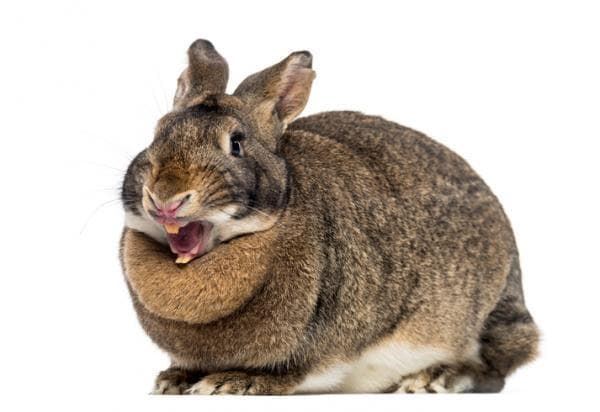
DIARRHEA IN RABBITS:
Diarrhea is dangerous in rabbits because they can dehydrate very quickly.
Diarrhea can appear for different reasons, such as spoiled food that may contain some intestinal parasites, such as bacteria, fungi or viruses, or problems with some recent changes in your diet or nervousness and discomfort.
Diarrhea in rabbits can lead to swelling in the belly, loss of appetite, loss of liveliness, increased thirst, apart from the soft or liquid feces that you can see on the ground.
An important fact to keep in mind is that whenever you see a stain on the straw or the floor of their cage and you have doubts as to whether it is diarrhea or vomiting, think that it will always be diarrhea because rabbits cannot vomit.
The severity of diarrhea in rabbits varies depending on the cause of the problem, the general state of health of the rabbit, etc.
If your rabbit suffers from diarrhoea, give it plenty of fresh water so that it does not become dehydrated, keep it somewhere where it is not cold and go to the vet immediately.
The main causes of diarrhea in rabbits are:
- Diet with excess protein.
- High-carbohydrate, low-fiber diet.
- Sudden change of diet.
- Stress.
- Coccidiosis in rabbits.
- antibiotics
DISTEMPER OR COLD IN RABBITS:
It is rare for a rabbit to catch a cold compared to people, but it can happen that a rabbit catches a cold, whether it is a farm animal or if it is in a house, and this problem is also known as distemper.
It can appear at any time of the year and you will notice it quickly because you will see that it has nasal and ocular secretions, as well as numerous sneezes, watery and swollen eyes...
You can catch a cold due to poor hygiene or sudden changes in temperature, drafts, etc., which lower your defenses.
Avoid getting a cold as it can lead to something more serious, such as pneumonia.
If you see that your rabbit does not improve in two or three days, go to your veterinarian, because this type of distemper is not so dangerous, but the mucus accumulated in the nose can cause respiratory distress and there may also be an accumulation of bacteria, both in the nose as in eyes.
To prevent this from happening, be very strict about hygiene and do not expose your rabbit to sudden changes in temperature or draughts.
That his cage is in a dry and warm place.
MANGE IN RABBITS, A VERY CONTAGIOUS DISEASE:
There are different types of mange in rabbits, the one that occurs in various parts of the body, more generalized, or the one that is specific to the ears, ear mange.
Mange in rabbits is a disease caused by mites and is highly contagious between rabbits.
Therefore, if you have several and detect any symptoms of scabies, you have to separate them.
You will see symptoms such as redness on the skin, small wounds, constant scratching, peeling, scabs...
These signs may be localized or generalized, depending on the type of scabies and its progression.
If you notice symptoms, you should go to the vet immediately, because if you don't act quickly, your rabbit could get worse and even suffer secondary diseases.
CONJUNCTIVITIS AND EYE INFECTIONS IN RABBITS:
Also known as red eye disease in rabbits, conjunctivitis is a condition that involves inflammation of the mucous membranes of the eyelids and the tear duct and also redness of the eyeball.
It can be accompanied by an infection or end up leading to one easily.
Your rabbit would have red, watery and rheumy eyes.
If there is infection, the legañas will have green mucus or pus.
In severe cases, the hair around the eyes is stuck, the eyes are filled with rheum and secretions until the eyelids are together, which prevents the animal from opening its eyes normally.
If you notice that your rabbit may have conjunctivitis, take him to the vet so that he can prescribe a suitable eye drop and guide you in the process of improving your rabbit.
They are produced by bacteria on the eyelids of rabbits.
Conjunctivitis can be of non-bacterial origin, the cause being the irritation produced by different allergens, such as household dust, tobacco smoke or the dust that can be produced in your bed if it contains highly volatile particles such as sawdust .
If you do not treat it well and in time, it will get worse and you will see your rabbit with pus in the eyes and the infection spread.
This would be very serious, since apart from the eyes being affected, the infection can end up in other important organs or in the blood, causing the death of the animal.
Never let infections pass, wherever they are.
OTHER COMMON DISEASES IN RABBITS:
Although the most common diseases in domestic rabbits are those mentioned above, they can suffer from others, they are more frequent in those that are wild or have a lot of contact with other rabbits or other animals.
These are other common diseases of field and farm rabbits:
Diseases in rabbits: bacteria and fungi:
- Pasteurellosis.
- Pneumonia.
- Tularemia.
- Coccidiosis.
- abscesses all over the body
- Pododermatitis or plantar calluses.
- Rabbit ringworm.
- Ear infections or otitis.
- Coliforms.
Viral diseases of rabbits:
- Myxonatosis.
- Rage.
- Clicivirus that causes rabbit hemorrhagic disease.
Parasitic diseases in rabbits:
- Fleas.
- ticks
- Mites
Lice. - Coliform infection.
Other health problems in rabbits:
Entropion or invagination of the eyelids.- Stress.
- Overweight and obesity.
- Heatstroke.
BASIC CARE FOR RABBITS TO PREVENT THESE DISEASES:
.
- Make sure you offer him the appropriate diet for the species, also taking into account his age and general health.
- You can never be short of fresh hay and water.
- Offer him a small amount of daily feed (a small spoonful) and the rest of the daily diet ensures that it is based on foods full of fiber and natural.
- It is not necessary for you to bathe him if he is not very dirty, because they wash themselves.
Take special care of their teeth and ears (especially with the long ears of belier rabbits). - Make sure you cover the vaccination schedule and the deworming schedule well.
If you detect any symptoms of possible illness or any change in their physical appearance or behavior, quickly contact the veterinarian.
.

